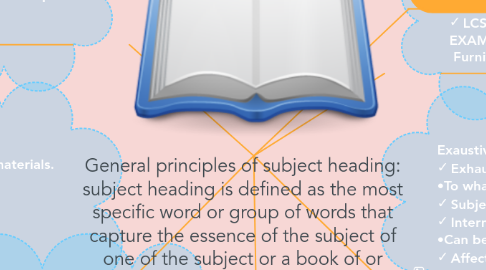General principles of subject heading: subject heading is defined as the most specific word or group of words that capture the essence of the subject of one of the subject or a book of or other library material example: serials,sound recording,moving image,cartographic material,manuscript,computer file, e-resources etc.
by DEEPIKA JAISWAL

1. Specific Entry ✓Terms are co-extensive with subject. ✓ we can say that each subject is represented by the most precise term naming the subject, rather than a broader or generic term that encompasses it.
2. Dymanism ✓Changes to headings are made continuously to maintain the currency and viability of LCSH ✓The benefit of making a change is weighed against its impact on the authority and bibliographic databases and the resources needed to carry it out.
3. Choice among terms: ✓Based on standard, contemporary American English – language usage ✓Preference given to terms in general use over technical terms or jargon where possible Vocabulary: ✓Attempts are made to choose neutral inclusive or unbiased terminology especially regarding topics that might to be controversial.
4. Postcoordination: ✓Combining of headings for keywords by a searcher at the time he/she looks for materials. ✓Manik complex or multi-element topics require postcoordination in LCSH EXAMPLES: For a work on the architecture of Roman public baths in Great Britain: •baths, Roman-Great Britain •architecture, Roman – Great Britain •Great Britain-Antiquities, Roman
5. Uniform Heading ✓One heading is chosen to represent a topic ✓This allows materials about a topic to be retrieved together if they contain different terms for the topic. ✓References to headings are made from synonyms and variant forms. ✓Catalogue users are guided from their entry vocabulary to the authorised headings.
6. Unique Heading ✓Each heading in LCSH represents only one topic. ✓If a term could represent more than one concept, it is modified: FOR EXAMPLE_ Rings(algebra). Stilts Rings (gymnastics). Stilts (birds) ✓Or, a [heading]--[subdivision] combination is created to provide context. ✓In cases where a decision is made to allow heading to represent more than one concept, a scope note is generally provided. For example_ LETTER WRITING Scope note:here are entered general works and works on English letter writing.
7. Precoordination: ✓Combining elements into one heading string in anticipation of a search on that compound topic. ✓LCSH is primarily a Preco-ordinate system EXAMPLES: Furniture design-France-history-20th century-exhibitions.
8. Examples of recent changes: 1) Handicapped ✓People with disabilities 2) Internet (computer network) ✓ Internet 3) Machine-readable dictionaries ✓ electronic dictionaries 4) Medicine, State ✓ National health services
9. Specific entry examples 1) For a work on Colombian drama, use: ✓ not Colombian literature ✓no drama 2) For a work on semi professional baseball, use: ✓not baseball ✓not ball games
10. Consistency & Predictability ✓Consistency in the form and structure of heading promotes predictability for subject heading users. ✓Predictability is enhanced when the terms chosen for a topic are those most widely used to repair tool that topic. ✓When headings are changed or new headings established, headings in bibliographic records need to be updated.
11. Specific entry: Exception ✓Some terms may be deemed too narrow comma and therefore not likely to be sought by catalogue users EXAMPLES: BAIT FISHING is an authorised heading in LCSH worm fishing is a specific type of bait fishing, but the heading Bait fishing is used to represent it.
12. Literary Warrant ✓subject headings are created for use in cataloguing and reflect the topics covered in a given collection ✓the terminology selected to formulate individual subject headings reflect the terminology used in current literature
13. Exaustivity & Subject Depth ✓Exhaustivity: Number of concepts represented in a bibliographic record. •To what extent to the subject headings reflect the subject matter of a work? ✓Subject(or indexing) depth: number of headings assigned to a work. ✓Internelinked concepts •Can be considered the breadth and depth of subject indexing. ✓Affect retrieval.
14. Consistency ✓Attempts are made to maintain consistency in form and structure among similar headings. ✓Indivisible headings, unless they have been revised, the prevailing philosophy in force at the time they were created.


